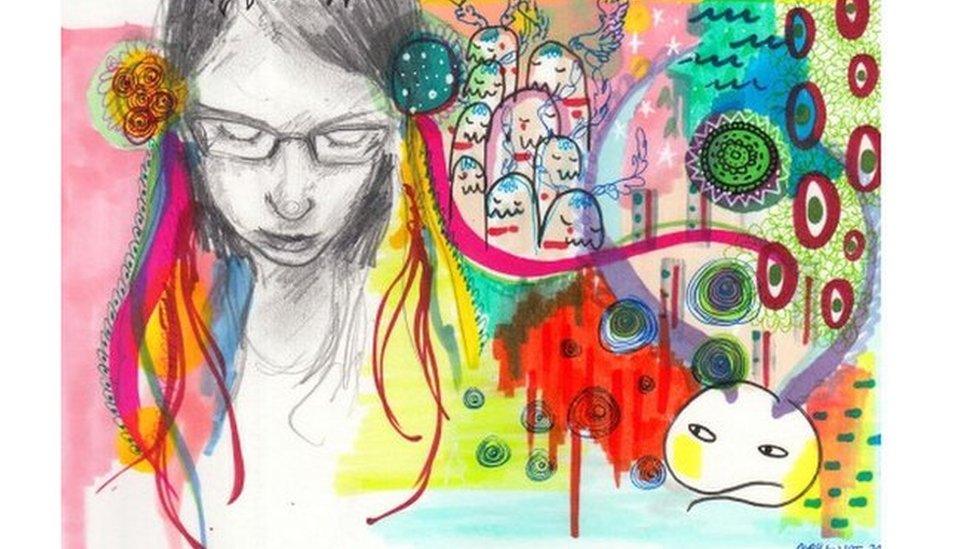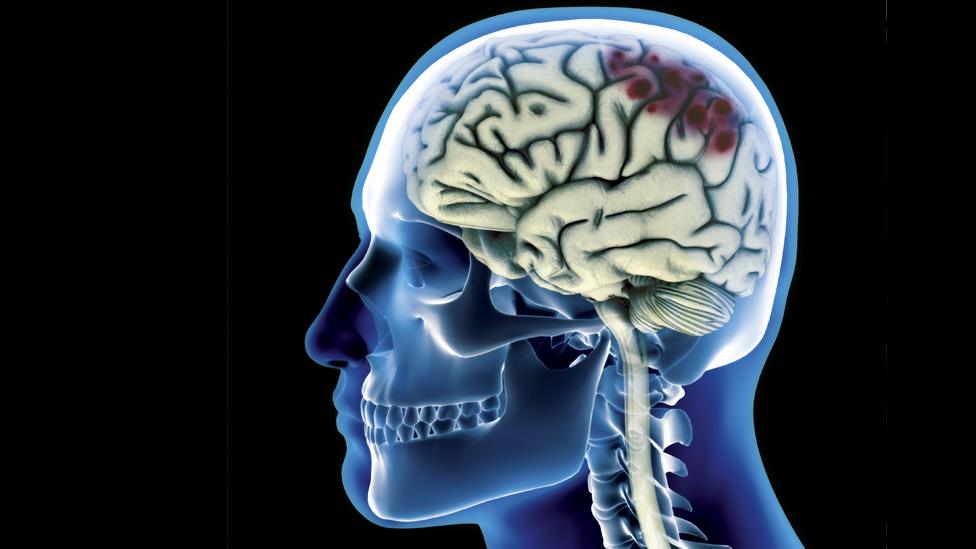'Take my brain out': The artists awakened by brain injuries
- Published

Thirty extraordinary artists who survived brain injuries, but found a new craft, are exhibiting their work in London this month, many for the first time.
For five days a week the art studio at Headway East London, set within a railway arch in Hackney, comes to life with people acquiring new skills and producing artwork.
Many had shown little or no interest in art until they were injured and invited into the studio.
Each member of Headway East London acquired their injuries as an adult. Some as a result of violent assaults, car crashes or meningitis, while others are from less common causes including hypoxia - a suffocation injury.
Ben Graham from the Headway charity says: "Quite a few of the people we're tending to see can't do their former jobs, or their relationships have broken down or maybe they're the parent but need caring for themselves.

Sandra Lott worked in banking in the City of London and would often travel to Europe and America on business. She suffered head trauma in 2013. The resulting injury means she walks with a stick, has cognitive fatigue and aphasia - a communication disorder.

"When I was at work, I fell over and security got me to the hospital. I was there for three days and then I was okay, but then I fell over on the stairs. Me and my friend we just had a coffee. I was walking around Liverpool Street and there were loads of steps, and that's when I fell on them.
"I was sick for a year. But then, when I came to Headway I just loved it."
Sandra enjoyed art as a child, but gave up as a teenager. One of the pieces she is exhibiting, Witches and Buildings, was inspired by 9/11. She had been working in New York shortly before.

"I had crabs and lizards and there was a man who was going into a helicopter - they were helping them after the World Trade Centre. That was because three weeks before, I went to the city. All the people who died, it was awful."
Sandra says her family has been very supportive of her art.
"My husband's going to come to the exhibition. He loves it. My husband is a photographer. I used to help him. I think in 2017 I would like to help his photography - I really want to do it."

Headway East London started in 1997 with one therapist and a single client. It's since grown and offers a variety of services. Rather than short-term rehabilitation with a discharge date it hopes to offer support as long as is needed; helping to redefine the person and giving them a positive outlook and productive use of their time.
Many of the 40 members who use the studio now consider art their job.
Graham says "Therapy is about making yourself better, but what they're doing is about making something, selling it to people, engaging with the public and forming an identity they feel comfortable and happy with.

"Essentially they're no longer unemployed, which affects their self-worth, and gives people that root to self-expression."
Headway is based in a unit complete with a kitchen, gym and therapy rooms with the Submit To Love Studio next door providing a bespoke space for painting, sculpting and ceramics.
When it first opened Graham says it led to an "explosion" of artwork and an "astonishing uptake" which they hope to continue nurturing.

Nick Mayers, 56, had spent 16 years in the Parachute Regiment before he had two strokes in one year. The second resulted in a haemorrhage which has affected his speech, memory and mobility. Nick will often paint images he sees in books.

"I was born, Nicholas Mayers. I was born 4th January, Battersea Park. When I was four-years-old I first started to paint."
Nick's strokes meant he has had to teach himself how to draw using his left hand, despite having grown up right-handed."
For anyone thinking of taking up art Nick has some advice: "Make it up as you go along. When I finish painting I never look back. Don't get attached."

Some of the artists have exhibited before but for many it will be the first time the public has a chance to see and buy the pieces with any profits split 50/50 between the artist and charity.

Graham says Headway East London is "not in a hurry to make it a commercial enterprise" but already prices have increased. Drawings used to go for about £20, but one artist has sold a piece for £1,600 and has a further eight chosen for £2,400.
"I don't think financial gain is the priority. Feeling valuable and engaged and pursuing something meaningful to them is the most important thing, and in a setting where they're connecting with others," Graham says.
"They're doing art for its own sake. It's a really exciting time for us and we all share that sense of pride together as a community."

Phil, a 44 year old father-of-two, was a pedestrian in a road traffic accident in 2015. He has problems with physical and cognitive fatigue, memory and concentration.

"I used to draw for my kids. I suppose I did have an eye but it didn't connect to how I would normally do things.
"I was really confused that I couldn't draw a line. Before the accident I would have been fine."
He said he struggled at first spending whole days working on it before declaring "I've failed" but after taking a more relaxed approach art has become his release.
"The piece I'm doing now - it's massive. It's a painting collage. It's a bit to do with me - the dark to the light. I think it's like my journey of this accident."

He says before he started at Headway he wasn't sure what to expect.
"People think it's like AA [Alcoholics Anonymous] - where you sit around in a circle and give out your feelings. This is totally different. This is my space from 10 'til 3, I take my brain out and recharge it.
"It's a wonderful place to recharge my brain and I'm allowed to be myself."

Submit To Love Studios, external runs until 23 February at Stratford Circus Arts Centre. All images used are courtesy of Headway East London.
- Published12 November 2016

- Published21 July 2015

- Published27 May 2015
